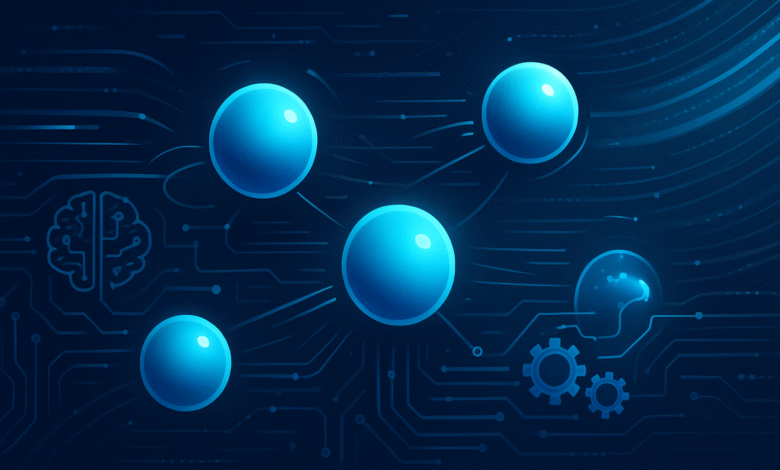
The way businesses operate is about to change fundamentally. Not through some distant sci-fi scenario, but right now, with AI agents quietly reshaping how work gets done. If you’ve heard the term “autonomous AI agents” tossed around in tech circles and wondered what the fuss is about, you’re not alone. These systems represent a genuine leap forward from traditional software and even from the chatbots you’ve probably interacted with already.
Here’s what makes them different: while a typical application follows predefined instructions like a recipe, AI agents actually think about what they’re doing. They can break down complex objectives into smaller tasks, execute those tasks independently, learn from the results, and adapt their approach the next time. Think of them as employees who don’t need constant direction and actually get smarter as they work.
This matters because businesses are drowning in repetitive, time-consuming tasks. Customer service teams answer the same questions over and over. Finance departments manually process invoices. Sales teams dig through data to identify leads. Autonomous AI agents can handle all of this, freeing your team to focus on work that actually requires human judgment and creativity. The AI agents market was valued at roughly $6.8 billion in 2024 and is expected to grow at more than 30 percent annually through 2034. That growth rate tells you something important: this isn’t hype. It’s happening, and it’s happening fast.
What Are AI Agents?
At the core, an AI agent is a software system that performs tasks autonomously by designing its own workflows and accessing available tools. Unlike traditional software that follows hard-coded rules, AI agents use reasoning and decision-making to figure out the best path forward, even when facing situations they haven’t encountered before.
The key distinction here is autonomy. A regular software program does exactly what it’s programmed to do, no more, no less. An autonomous AI agent, by contrast, takes a goal you give it and figures out how to achieve that goal. It perceives its environment, analyzes information, makes decisions, and takes action—all with minimal or no human intervention in between.
Large language models (LLMs) form the backbone of most modern AI agents. These are the same underlying technologies powering ChatGPT and similar systems, but LLM agents are designed to do much more than just generate text. They use natural language processing to understand what you’re asking, then connect to external tools and data sources to actually execute tasks. This combination of reasoning capability and tool integration is what transforms a language model into an actual agent that can accomplish real business work.
How AI Agents Actually Work
Understanding how AI agents function gives you insight into why they’re so powerful. The process generally follows a predictable pattern, though the specific steps vary depending on the agent’s complexity and purpose.
Step 1: Goal Reception and Planning When you give an autonomous AI agent an objective, its first job is to understand what you’re asking and break that down into manageable parts. The agent uses its machine learning capabilities to reason through the problem and create a plan. This might involve multiple sequential tasks or branches depending on what information it uncovers along the way.
Step 2: Information Gathering AI agents don’t work in isolation. They need data to make good decisions. This is where tool integration comes in. An agent might search the internet for current information, query internal databases, access APIs, or connect to other systems. This ability to gather real-time, accurate information is a huge advantage over traditional static software that relies on outdated hardcoded data.
Step 3: Decision-Making and Action Armed with information, the agent analyzes the data using its underlying machine learning models and decides what action to take next. Should it escalate this issue to a human? Can it handle it directly? Does it need to gather more information? The agent makes these judgment calls dynamically, without waiting for human approval at each step.
Step 4: Monitoring and Feedback After taking action, the agent doesn’t just move on. It monitors the results and gets feedback from the environment. Did the action achieve the desired outcome? Was there an error? This feedback loop is crucial because it allows autonomous AI agents to continuously improve. They learn from successes and failures, refining their approach over time. This self-learning capability is what separates true AI agents from basic automation.
Types of AI Agents You Should Know About
Not all AI agents are created equal. Different types of intelligent agents are suited for different jobs, and understanding the distinctions helps you figure out which kind of agent your business actually needs.
Simple Reflex Agents These are the most basic type of autonomous agents. They react to their immediate environment based on predefined rules, much like a thermostat. If the room is too cold, they turn on the heat. If it’s too warm, they turn on the AC. No memory, no complex reasoning. Simple reflex agents are good for straightforward, repetitive tasks where the correct action is obvious based on current conditions.
Model-Based Reflex Agents A step up in complexity, these agents maintain an internal model of the world. They remember past states and understand how things have changed over time. This allows them to reason about their environment more effectively, even when they can’t see the complete picture. They’re useful for tasks that require some understanding of cause and effect.
Goal-Based Agents These intelligent agents have a specific objective in mind and plan their actions to achieve it. They can consider multiple possible approaches and choose the one most likely to reach their goal. This is closer to how human decision-making works. A sales agent that identifies high-potential leads from a CRM database is an example of a goal-based autonomous agent.
Utility-Based Agents The most sophisticated type prioritizes not just achieving a goal, but achieving it in the optimal way. They measure outcomes using a “utility” score and choose the action that maximizes that score. A ride-sharing app that tries to minimize your wait time while also keeping costs down is using this approach. Multiple valid solutions exist, but utility-based agents find the best one.
Learning Agents These AI agents have the ability to improve their own performance over time. They start with some initial knowledge, but they learn from experience, updating their internal models and refining their strategies. This is where the real intelligence comes in. Learning agents are increasingly common because they get smarter the more they’re used.
The Role of Large Language Models in Modern AI Agents
You can’t talk about AI agents today without discussing LLM agents. Large language models changed the game by providing a general-purpose reasoning engine that could be connected to tools and data sources.
LLMs excel at understanding context, reasoning through problems step-by-step, and generating plans. When you combine an LLM with access to external tools—APIs, databases, search engines—you create something genuinely powerful. The LLM essentially becomes the brain that figures out what needs to happen, while the tools become the hands that actually do it.
This is what tool calling means. When an LLM agent needs to perform an action beyond generating text, it “calls” a tool. It might ask to search the web, pull data from a database, send an email, or update a record. The LLM decides which tools to use based on the goal and the current situation. This flexibility is key to making autonomous AI agents useful across different industries and business processes.
The beauty of using LLMs as the foundation for AI agents is that they can understand nuanced language and context. If a customer writes a complaint with sarcasm or unclear wording, an LLM agent in customer service can still grasp the underlying issue and take appropriate action. Traditional rule-based systems would likely fumble that scenario.
Real-World Applications That Matter Now
AI agents aren’t theoretical. They’re being deployed today to solve actual business problems. Here’s where you’ll see the biggest impact:
Customer Service and Support Imagine a customer reaches out with a billing question. An autonomous AI agent can pull up their account details, review their history, identify the issue, and solve it—sometimes without any human involvement. If the problem is complex, the agent escalates intelligently rather than dumping the confused customer back to a random queue. The agent learns from each interaction, getting better at anticipating issues and solving them proactively.
Finance and Accounting Invoice processing, expense reports, accounts payable—these are areas where AI agents shine. An agent can extract data from invoices, validate it against purchase orders, flag discrepancies, and route everything for approval. This kind of workflow automation eliminates hours of manual data entry and reduces human error dramatically.
Sales and Lead Generation Intelligent agents can analyze customer data, website behavior, and historical sales patterns to identify your best potential customers. They can qualify leads, prioritize follow-ups, and even engage in initial conversations. Your sales team spends their time on deals that actually have a chance of closing.
IT Operations AI agents can monitor systems, detect problems, and often resolve them without human intervention. If a server is running slow, an agent can diagnose the issue, check resource usage, clear caches, or escalate to a human engineer if needed. This 24/7 capability is something no fixed team size can provide.
Supply Chain and Logistics From demand forecasting to inventory optimization to shipment tracking, agentic systems can handle the complexity of modern supply chains, making real-time adjustments as conditions change.
Why AI Agents Are Different from Regular Automation
This is important to understand: AI agents are not the same as traditional business automation or robotic process automation (RPA).
Traditional automation systems are rigid. You program them to follow specific sequences of steps in specific situations. If something unexpected happens, they break. They don’t learn, and they can’t adapt. If a customer provides information in an unexpected format or asks something slightly different from what the automation was designed for, the system fails.
Autonomous AI agents, by contrast, are flexible and adaptive. They reason through situations, handle variations, and learn from experience. They can pursue goals rather than just executing predefined steps. This means they’re actually useful in complex, changing environments where every scenario isn’t known in advance. That’s most of business.
Think of traditional automation as following a recipe exactly. AI agents are like having a chef who understands cooking principles and can improvise when you’re missing an ingredient or need to adjust for dietary preferences. The flexibility is what makes them genuinely transformative.
The Benefits of Implementing AI Agents
Why are companies investing in autonomous AI agents so heavily? The benefits are concrete and measurable.
Cost Reduction Automating routine tasks eliminates the need for people to do tedious, repetitive work. Your team can be smaller while accomplishing more. Processing time drops from hours to minutes. Error rates decrease because machines don’t get tired or distracted. Over time, these efficiencies add up to serious cost savings.
Speed and Scalability Humans have limits. An employee can handle so many customer inquiries per day. An AI agent can handle thousands. Want to expand your operations without proportionally expanding your staff? Autonomous AI agents let you scale without that constraint.
Improved Decision-Making AI agents can process and analyze massive amounts of data far faster than human teams. They can identify patterns you’d never spot manually. For business leaders, this means better decisions based on more complete information. In financial markets, it means faster reactions to new data. In customer service, it means genuinely personalized solutions.
24/7 Operations Intelligent agents don’t sleep. They can handle customer inquiries, monitor systems, and execute tasks around the clock. This matters enormously for global businesses serving customers across time zones.
Better Customer Experience When issues are resolved quickly and accurately, customers are happier. AI agents can often solve problems on the first interaction. They remember customer history and preferences, enabling genuinely personalized experiences that feel thoughtful, not generic.
Challenges and Considerations
It’s not all smooth sailing. There are real challenges to implementing AI agents effectively.
Reliability and Accuracy AI agents can hallucinate—generating confident-sounding but completely false information. They can make mistakes in reasoning. This is why oversight matters. Most implementations today require some level of human review, especially for high-stakes decisions.
Data Quality and Bias AI agents learn from data. If that data is biased or poor quality, the agent’s behavior will reflect those problems. A lending agent trained on biased historical data might unfairly reject loan applications from certain groups. This is a serious concern that requires careful attention.
Integration Complexity Getting autonomous AI agents to work with your existing systems isn’t always straightforward. Your data might be scattered across multiple platforms. Legacy systems might not have good APIs. Integration takes real work.
Governance and Control Letting systems make autonomous decisions raises questions about accountability, transparency, and control. If an AI agent makes a harmful decision, who’s responsible? How do you audit what the agent decided and why? These are questions your organization needs to answer before deploying agents to critical functions.
The Future of AI Agents
Where does this technology go from here? The trajectory is clear, even if the exact timeline isn’t.
Multi-Agent Systems The real power emerges when multiple autonomous AI agents work together. One agent might handle data validation, another handles routing decisions, a third manages escalations. Multiple specialized agents often outperform a single general-purpose agent. Imagine a fleet of intelligent agents, each expert in their domain, coordinating to handle complex workflows. This is coming.
Deeper Integration with Everyday Tools AI agents will become embedded in the software you already use daily. Your email client might have an agent that prioritizes messages and drafts responses. Your spreadsheet application might have an agent that analyzes data and generates insights automatically. The distinction between “tools” and “AI agents” will blur.
Improved Reasoning and Planning The underlying machine learning models will get better. Agents will reason more carefully, plan more effectively, and make fewer mistakes. This won’t make agents perfect, but it will make them trustworthy enough for higher-stakes decisions.
Industry-Specific Agents We’ll see purpose-built autonomous AI agents for specific industries. Healthcare agents that understand medical protocols and patient data. Legal agents that understand contracts and compliance. Manufacturing agents optimized for production scheduling. These specialized agents will be more capable than general-purpose systems.
Getting Started with AI Agents
If you’re thinking about deploying autonomous AI agents in your business, start small. Identify a process that’s repetitive, well-documented, and not critical to your core operations. This could be basic customer service inquiries, simple expense report processing, or data extraction from emails.
Start with a pilot. Build or deploy an agent, monitor its performance carefully, and refine. As you gain confidence in the technology and learn what works in your environment, you can expand to more complex use cases.
Focus on integration. The real value comes from connecting AI agents to your existing systems and data. An agent that can’t access the information it needs is useless. Invest in making your data accessible.
Remember that humans remain essential. Not for doing the routine work—that’s where autonomous AI agents excel—but for setting goals, monitoring performance, handling edge cases, and making judgment calls that involve values or nuanced tradeoffs. The best outcomes come from humans and intelligent agents working together, each doing what they do best.
For more detailed information about how enterprises are implementing autonomous agents, check out IBM’s comprehensive guide to AI agents, which covers architecture, capabilities, and real-world deployment strategies. You might also find AWS’s overview of AI agents helpful for understanding how these systems integrate with modern cloud infrastructure.
Conclusion
AI agents represent a genuine shift in how work gets done. We’re moving from a world where software executes instructions to a world where software pursues goals, reasons about problems, and continuously improves. The autonomous AI agents market growth tells you this isn’t a passing trend—it’s a fundamental change in technology. The companies and organizations that effectively deploy agentic AI will operate faster, with lower costs, and with better decision-making than those that don’t. Whether you’re a business leader, a technology professional, or simply someone curious about where technology is heading, understanding AI agents matters. They’re not the future anymore. They’re here, they’re improving rapidly, and they’re reshaping what’s possible for every organization willing to embrace them.







